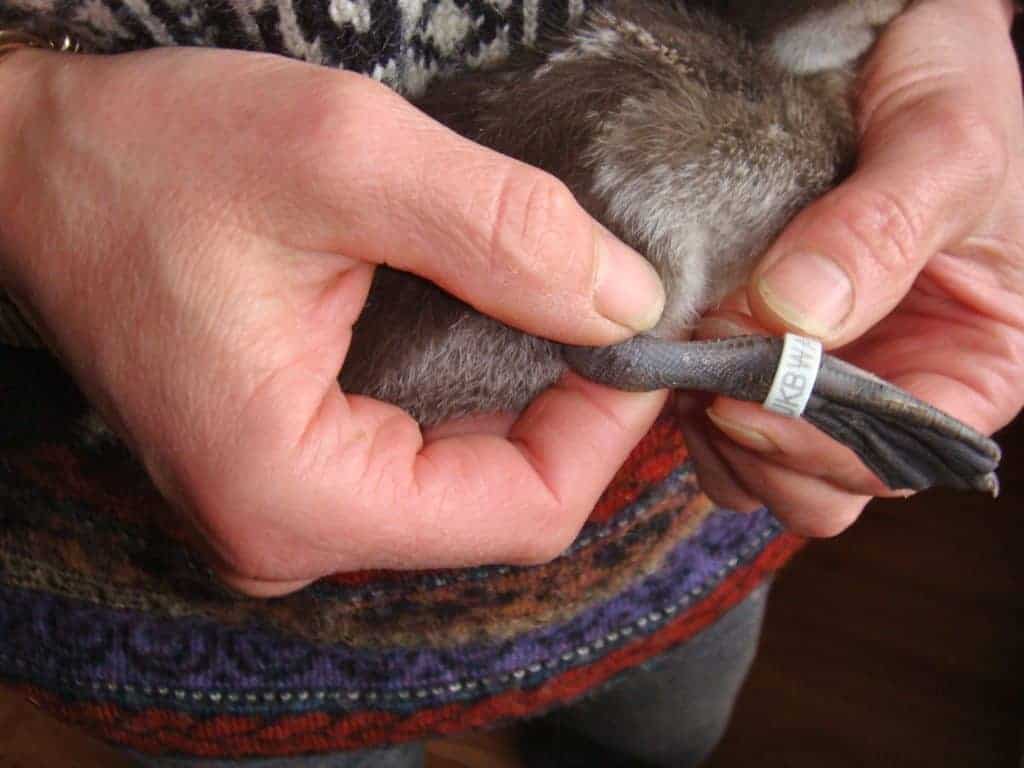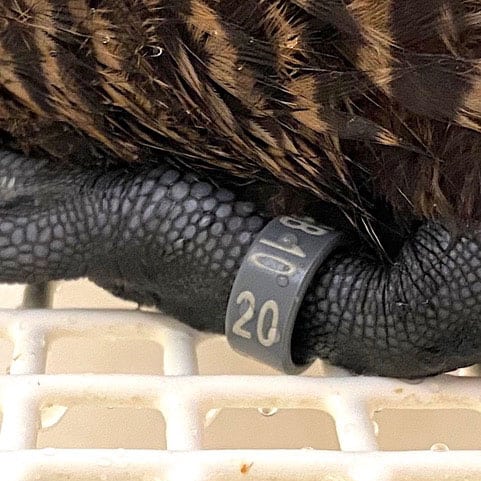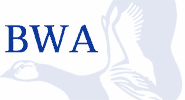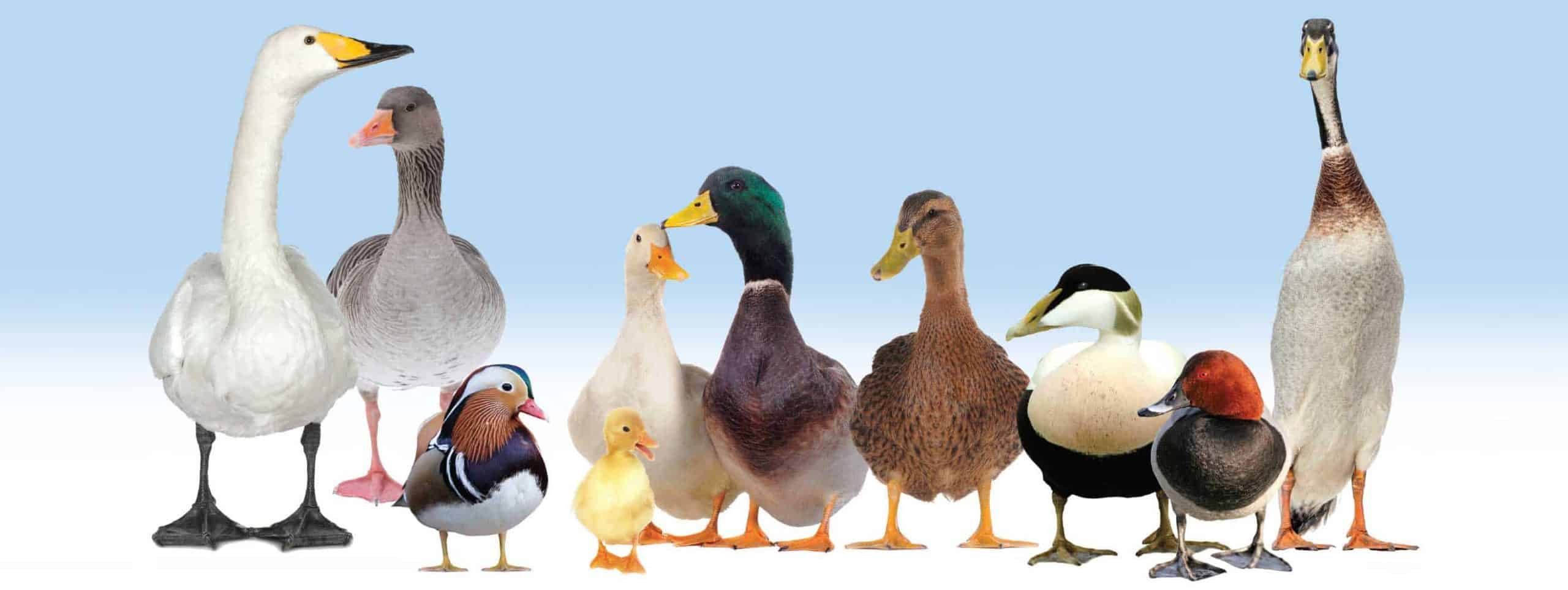Ringing your Waterfowl
Home » Husbandry » Raising Waterfowl » Ringing your Waterfowl

A closed ring identifies a bird as having been raised in captivity and can serve as proof of ownership. Numbered rings are also invaluable in maintaining records. Some breeders use coloured flatband, spiral or divided metal rings purely for their own records or to identify bloodlines. Closed rings may be made from metal (often an aluminium alloy) or coloured plastic. There are several considerations when choosing a leg ring size:
Above all else is the welfare of the bird.
A closed ring is fitted to the growing bird at the point when it fits snugly over the foot so it does not fall off. For some wildfowl species, this is a very short window.
It is important that the ring cannot slip up over the ankle (hock) joint.
Grit and mud can lodge underneath the ring if it is too tight, so the sizes allow for this.
If a ring is too big, there is more likelihood of a leg being caught on unexpected hazards.
Conventionally, males are ringed on the right leg and females on the left if the birds are sexed at this stage. Breeders sometimes use left and right to identify bloodlines so this is not universal.
Ring rules for exhibition birds vary from country to country. In the UK, only closed rings are accepted on show birds. Currently these are issued by the Poultry Club of Great Britain.
The health and well-being of a ringed bird should be closely monitored — rings should be checked frequently, and MUST be inspected every time a bird is handled.
The ring should be cut off immediately if there is ever swelling or injury to the leg.

Husbandry FAQ
- Activated charcoal
- Antiseptic wipes/hand gel
- Clean crate with fresh wood shavings always ready
- Cotton bag to carry the bird
- Micropore tape
- Nail clippers
- Preparation H ointment (not gel)
- Saline solution (eyewash)
- Sam splint
- Scissors/cutters
- Surgical gloves
- Tick remover
- Tweezers/forceps
- Vet surgery contact details to hand
- Veterinary wound powder
- Vetwrap bandage
- Wing restraints (socks/towels/custom made jackets)
The principles of biosecurity are frequently discussed, particularly in respect of the now possible threat of Avian Influenza. Biosecurity is essentially the creation of a microbiological barrier to prevent contact between the pathogens (in this case Avian Influenza Virus) and the host (domestic or captive waterfowl).
The purpose of this note, therefore, is to consider aspects of biosecurity which can be put into place to protect these populations of waterfowl. Every waterfowl keeper will have a different set-up and it is possible to adapt their situation to fit in with these guidelines.
We should understand both the nature of the virus and the circumstances under which the virus can be introduced to our livestock. There are two main ways the virus might be introduced. Firstly there is the risk of direct spread from migrating birds and secondly the indirect spread from these or another infected population.
Migrating waterfowl will be attracted to stretches of water and in the case of geese associated grazing.
The safest approach is to bring all susceptible livestock indoors and to keep them so confined for the length of the risk period. Should this not be possible, then birds should be fenced well away from their swimming water if this is fed from a watercourse. Efforts should then be made to avoid wild birds visiting the livestock.
An extra safeguard is to supply the feed and water inside the bird housing. Outside large water troughs must be avoided.
Having penned the birds away from water, it is an additional precaution if those pens can be netted over to prevent wild bird access. Your birds could be allowed access to a mains fed pond if it can be included in the netted area.
The virus is spread from the wild birds through the faeces. These will contaminate the edges of the ponds as well as the pond water itself and also any grazed pasture. The precautions taken must consider how these faeces might get walked into the livestock pens.
- Avoid walking round the ponds.
- Do not go fishing, when clothes, footwear, vehicle and fishing equipment could become contaminated.
- Change footwear before entering livestock pens (do not rely on foot dips).
- Do not let dogs or other pets enter the livestock pens.
- Always ensure the water provided to the birds is clean mains water
- Drain or fill in any puddles.
Whilst migrating waterfowl may not visit your ponds they may be visited, for example, by local Mallard which could have picked up the virus from other ponds.
The other precautions to have in place are to avoid direct or indirect contact with other domestic waterfowl (or poultry) collections.
- Do not borrow equipment from others.
- Do not lend equipment to others.
- Do not let other people visit your waterfowl.
- Any staff must not have their own livestock nor have contact with other people’s livestock.
- Do not visit other people’s livestock.
- Do not bring other birds into your livestock pens (purchases, borrowings, gifts etc)
- Do not take your birds to shows, exhibitions, etc nor bring birds from these events.
- Do not lend your birds to anyone (eg a drake for mating other people’s hens)
- Do not share a feed delivery with anyone.
- Ensure stocks of feed are kept undercover in a clean, dry, rodent-free store.
- Collect up and discard any spilled feed.
- Don’t share incubation facilities with others.
Whilst this might not be a comprehensive list of precautions, it is sufficient to stimulate thoughts on the precautions to take.
If in doubt about anything, don’t do it.
The time to introduce these precautions is now. Don’t wait for the infection to be diagnosed in the country. Yours could be the first infected premises. Register all livestock, however small the population, with DEFRA, who can then be expected to keep you informed of any increased risk of disease and keep you supplied with advisory notes.
If serious disease is seen in your birds, notify your veterinary adviser and DEFRA immediately. Remember, however, avian influenza in waterfowl may not make them sick. This is why you must be suspicious of any other stock which is not yours and appears healthy.
Please follow this advice as closely as possible.
I should be pleased to help if needed. Any questions should be submitted through the BWA secretary by letter or email info@waterfowl.org.uk
Keith Gooderham BVSc, DPMP, MRCVS, Specialist in Poultry Medicine and Production
We recommend you locate a veterinary practice which has a partner specialising in avian medicine. This should be done as a basic part of planning your facilities. Some farm practices might be able to help, recommendation from other waterfowl keepers can be invaluable.
Birds mask their symptoms well as defence against being targeted by a predator. With careful observation we can detect a problem developing.
Sick birds often sit hunched up with fluffed out feathers. They may lose appetite, or simply hide away.
The topics and advice on these pages are given in good faith. The intent is to provide a general overview but is not a replacement for specialist veterinary care. If you suspect any of the following, immediate veterinary assistance is recommended:
- Poisoning
- Broken bones (especially if bone has broken the skin)
- Attack by other animal
- Swallowing something sharp
- Significant wounds
- Difficulty breathing
- Eye injury
- Prolapse (phallus or oviduct) that cannot be replaced
- A need for pain relief
In the UK we face few restrictions as to which species of waterfowl we can keep. Only the (North American) Ruddy Duck is prohibited. This is to protect the endangered White-headed Duck.
As long as you keep them contained, that means not released or allowed to escape, you may keep all the other Anseriformes. All may be traded freely as long as they are individulally proven as captive bred. This means close ringed or microchipped for identification. Our native and ordinarily resident birds listed in Appendix 2 of the General Licence may be moved without a ring. Mute Swan and Egyptian Goose require an individual licence to be moved.
Our responsibility to these birds is to keep them in conditions sympathetic to a contented mental state. They should be adequately fed and watered, kept in comfortable conditions with relation to their size and normal habits, and sheltered from weather extremes. We should protect them from pain, injury and disease and allow them the freedom to express normal behaviour. We should do all in our power to protect them from fear and distress.
Essentially, these are summed up in the five freedoms of animal welfare. Expanded; four physical or functional domains of nutrition, environment, health and behaviour surround and influence the mental state. The Five Domains are key to the highest standards of welfare.
As the British Waterfowl Association we believe that the highest standard of welfare should remain one of our core values.
Read the paper about Fundamental Welfare Requirements here.
The clue is in the name – waterfowl. So the answer is yes.
The pond need not be huge for basic health, provided the water is changed frequently and kept clean. All waterfowl need to be able to fully immerse their heads in water, to keep eyes and nostrils clear. They nearly always wish to drink when feeding.
Clean water is also vital for bathing. Waterfowl know their survival is dependent on keeping their feathers in good condition, so a high proportion of their time is spent on washing and preening. They will have a regular routine of splash bathing, flapping, then rearranging their feathers.
Small bodies of stagnant water, especially in warm weather, can harbour disease. Waterfowl soil the water every time they bathe, so any disease or parasites present can be shared quickly amongst the flock.
Nearly all waterfowl prefer to mate on water. Particularly, the heavier breeds of domestic geese may be injured if forced to mate on land.
Geese and many of the ducks have evolved to eat grass – lot of grass. In the wild they range widely, mowing as they go. The intake of a goose is about 1/5 of that of your average sheep. Why eat so much? The answer lies in nutritional content. This varies according to the growth stage of the plant and also the season. All but the very freshest leaves are high in fibre and low in meaningful nutrition. No surprise then that newly emerged leaves are nibbled away with relish. Many people keep geese to manage grass and reduce the need to mow. There are merits in this strategy but only to reduce, not eliminate mowing. If the grass is bowling green short all summer, it will disappear completely over the winter.
Domestic ducks and geese are not always good parents, it very much depends on the breed.
Many breeders of domestic and wild waterfowl use small broody hens and have excellent results. Muscovy ducks are also used.
Wildfowl may reliably sit on a clutch. It will depend on the species as to how reliable they are if there is any disturbance in the vicinity. Some species are very secretive, like the Garganey. Others, like Eiders, will sit faithfully through all manner of civil unrest.
You will need to make a choice as to whether to lift the eggs early or leave the eggs under the mother.
There is a vast array of incubators on the market. Whichever one you choose, it is best to hatch in a separate hatcher. The bacterial contamination of hatching birds will affect any eggs of different stages still in the incubator.
The answer has to be that if you breed waterfowl with a view to obtaining birds of a particular type, then, like it or not, you are applying genetics. You are accepting that your birds are able to pass on features (in the form of genes) to their offspring, and that, by breeding only from those birds with the characteristics you want, you will ‘improve’ the next generation. By getting your head round some of the basic principles, you can save yourself a lot of time and hassle by realising what is or is not possible. If you are purchasing birds, you should be confident that the breeder has applied basic principles so that the birds you are buying are as you expect.
All domestic animals have been developed from wild ancestors by human intervention. Our domestic ducks, with the exception of Muscovies, are descended from the wild Mallard. The differences we see now have come about by mutations – random, rare changes in genes from those producing mallard characteristics, which humans have seized upon to breed selectively. In the wild, odd genes would disappear into the mass or the birds carrying them would be easy prey to predators, but in captivity they have been artificially selected for, and not only maintained, but combined in new ways, resulting in the wide range we see today.
So how does it work? Each living thing (including ducks) has a number of pairs of chromosomes in each cell of its body, carrying thousands of genes — one set from its father and one set from its mother. Since any duck receives one gene for a particular character from each parent it must have two genes for any character. Different versions of a gene are called alleles. Taking the simplest possible scenario, if these two alleles are the same, (called homozygous) there is no problem, the alleles will decide the feature and will show in that organism. If they are not the same (heterozygous), there are two possibilities. Often, one allele (the dominant one) will show itself (be expressed) and the other (recessive) will be hidden.
For example, the black colour seen in Cayugas, Black East Indians and others is caused by an allele that is dominant over the normal wild-type colour. If we use the letter E to represent the black, and e to represent the recessive wild colour, we can see that a black duck could be either EE or Ee, but a wild colour bird could only be ee. When these birds go on to breed, the homozygous black (EE) can only pass on E alleles, the wild type can only pass on one e allele, but the heterozygous can pass on E or e alleles. Thus, it would be quite possible that two black ducks could produce wild-type offspring (unless you could be sure they were EE) but virtually impossible for two wild-type birds to produce black offspring.
In other situations, one allele is not dominant over the other, so that if the alleles are different (heterozygous), the result is a form like neither parent but somewhere between, or different from either. This is called co-dominance. An example of this is blue colour, as in the Blue Swedish, where the blue results from two alleles being different, the homozygous situations giving Black and Splashed White. Only 50% of offspring from two Blue Swedish will be like their parents. The only way to get 100% Blue is to cross a Black with a Splashed White! Thus, it will never be possible to breed pure Blue Swedish, and it actually raises the question about whether this can be considered a true breed at all. A get-out here is that the inheritance in blue birds is at least predictable!
The single gene situation is not the norm — many characteristics are the result of a number of genes acting together, often one gene modifying the effect of another (such as dilution genes), so that it is often far harder to see the underlying principles at work. In addition, since there are colour differences between male and female ducks, there is the added complication of sex Iinkage.
Only 22 mutations in domestic ducks have been described so far — there is obviously much more work to do. Mike Ashton has given much more detail of the mechanisms of inheritance of some of these genes, in his articles in Waterfowl and in his and Chris’s book, The Domestic Duck. I am not proposing to repeat his work here, but to urge duck breeders to think about the mechanisms underlying their breeding programmes, to try applying some basic principles and to share information with others to add to the body of knowledge available. It would be especially useful to keep track of the numbers of different forms obtained from particular pairings.
There are two possible issues arising from a lack of regard or understanding of the underlying principles. Sometimes all colours of Calls, for example, are run together. Offspring are chosen which happen to correspond to show standard criteria for a particular colour for exhibition and sale and a great disservice is being done to that colour. In all probability the birds will have a number of recessive alleles which are not expressed but will show up in successive generations. In other words, despite appearances, they are cross-bred and will not breed true.
Another issue is from random crossing, where a colour of duck appears which is novel and which the breeder likes. It is easy to assume to assume that, by successive breeding and selection, eventually a pure-breeding line can be produced. In all probability, the ‘new’ colour only exists when a gene or probably genes, are heterozygous, in other words ‘split’, and a pure-breeding form will never be possible.
So, if you’ve never thought about the mechanism of inheritance in this way, give it a go. It can make sense of what you see happening and certainly adds interest to the breeding side of the hobby.
Geoff Chase
Waterfowl are naturally inquisitive and will uproot and nibble any plants in and around the pond. Some native and common garden species are poisonous. We suggest that these should be avoided in a waterfowl enclosure where they could be nibbled:
- Black (deadly) nightshade
- Bracken
- Bryony
- Castor Bean
- Clematis
- Common St John’s Wort
- Corn Cockle
- Daffodil bulbs
- Daphne berries
- Delphinium
- Some Ferns
- Foxglove
- Some Fungi
- Hemlock
- Henbane
- Hyacinth bulbs
- Hydrangea
- Most ornamental Irises
- Laburnum seeds
- Lily of the Valley
- Meadow buttercup
- Oleander
- Potato sprouts
- Privet
- Ragwort
- Rapeseed
- Rhododendron
- Rhubarb leaves
- Sweet pea
- Tulip
- Vetch
- Yew
Getting your first birds is exciting but we do need to put their needs first. Time spent on research is never wasted, so make sure you choose the right breed or species and have everything in place for their arrival.
See more here.
We hope it is. Our website content is available for all to use, but of course running our site has costs. Please credit any photographs and link back to the British Waterfowl Association. We hope you will join. Whether or not you do, will you help us continue to improve our content by making a donation?
Thank you.


